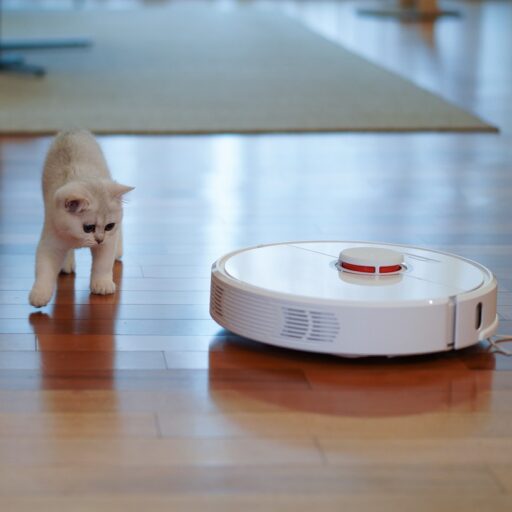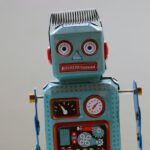Support our educational content for free when you purchase through links on our site. Learn more
How Do Bathroom Cleaning Robots Navigate & Map Your Space? 🧹 (2025)
Imagine a tiny robot gliding effortlessly across your bathroom floor, dodging towels, avoiding the toilet base, and scrubbing every nook without missing a spot. Sounds like sci-fi? Nope — it’s the magic of modern bathroom cleaning robots! But how exactly do these clever machines “see” and map out your bathroom’s tricky layout? From advanced sensors to AI-powered mapping, we’re pulling back the curtain on the tech that lets these bots clean smarter, not harder.
In this article, we’ll explore the 7 key technologies bathroom cleaning robots use to navigate and map your bathroom space, share real user stories, and reveal tips to optimize your bathroom for robot success. Plus, we’ll spotlight the top models with the best navigation systems so you can pick the perfect helper for your home. Ready to let a robot take over your bathroom chores? Let’s dive in!
Key Takeaways
- Bathroom cleaning robots rely on advanced sensors like lidar, infrared, and ultrasonic to detect obstacles and create detailed maps.
- SLAM (Simultaneous Localization and Mapping) technology is the backbone of real-time mapping and navigation.
- Machine learning and AI enable robots to adapt to changes in bathroom layouts and optimize cleaning routes.
- Top models like iRobot Braava and Samsung Powerbot lead the pack with superior navigation and obstacle avoidance.
- Optimizing your bathroom layout (clearing clutter, consistent setup) enhances robot efficiency and cleaning quality.
👉 Shop top bathroom cleaning robots:
Table of Contents
- Quick Tips and Facts About Bathroom Cleaning Robots 🚿✨
- Bathroom Cleaning Robots: A Brief History and Evolution 🧼🤖
- How Do Bathroom Cleaning Robots Navigate? The Tech Behind the Magic 🧭🔍
- Mapping the Bathroom: SLAM and Other Advanced Mapping Technologies 🗺️🛁
- Sensors Galore: What Bathroom Robots Use to See and Sense Their Environment 👀📡
- Obstacle Detection and Avoidance: How Robots Dodge Your Rubber Duck and Towels 🦆🚧
- Top 7 Bathroom Cleaning Robots with the Best Navigation Systems 🏆🤖
- Challenges in Bathroom Robot Navigation: Wet Floors, Tight Spaces, and More! 💦🌀
- User Experiences: Real Stories from Bathroom Robot Owners 🗣️🧽
- How to Optimize Your Bathroom for Robot Cleaning Success 🛠️🚽
- Future Trends: What’s Next for Bathroom Cleaning Robots? AI, IoT, and Beyond 🚀🤖
- Conclusion: Navigating Toward a Cleaner Bathroom with Robots 🧹🤖
- Recommended Links for Bathroom Cleaning Robot Enthusiasts 🔗
- FAQ: Your Burning Questions About Bathroom Cleaning Robots Answered 🔥❓
- Reference Links and Further Reading 📚
Quick Tips and Facts About Bathroom Cleaning Robots 🚿✨
As robotics engineers at Robot Instructions™, specializing in Your Guide to Robots, we’ve compiled a list of quick tips and facts about bathroom cleaning robots. Check out our related article about bathroom cleaning robot for more information.
Benefits of Bathroom Cleaning Robots
Bathroom cleaning robots can be a game-changer for maintaining a clean and hygienic bathroom. Some benefits include:
- Convenience: Schedule cleanings with the touch of a button
- Efficiency: Advanced navigation systems ensure thorough cleaning
- Hygiene: Consistent cleaning reduces the risk of germ buildup
Popular Bathroom Cleaning Robots
Some popular bathroom cleaning robots include:
- iRobot Braava
- Samsung Powerbot
- Neato Botvac
Bathroom Cleaning Robots: A Brief History and Evolution 🧼🤖

Bathroom cleaning robots have come a long way since their inception. From simple vacuum-like devices to advanced navigation systems, these robots have evolved to tackle the toughest bathroom cleaning tasks.
Early Beginnings
The first bathroom cleaning robots were introduced in the early 2000s, with companies like iRobot pioneering the technology. These early models were basic and lacked advanced navigation systems.
Modern Advancements
Today, bathroom cleaning robots boast advanced features like:
- SLAM (Simultaneous Localization and Mapping) technology for precise navigation
- Sensor arrays for detecting obstacles and avoiding collisions
- Machine learning algorithms for optimizing cleaning routes and adapting to new environments
How Do Bathroom Cleaning Robots Navigate? The Tech Behind the Magic 🧭🔍
Bathroom cleaning robots use a combination of sensors and mapping technologies to navigate and clean the bathroom.
Sensor Suites
These robots are equipped with advanced sensor suites, including:
- Lidar (Light Detection and Ranging) for creating detailed maps of the environment
- Infrared sensors for detecting obstacles and avoiding collisions
- Ultrasonic sensors for measuring distances and detecting changes in the environment
Mapping Technologies
Bathroom cleaning robots use various mapping technologies, including:
- SLAM (Simultaneous Localization and Mapping) for creating and updating maps of the environment
- Occupancy grids for representing the environment as a grid of occupied and unoccupied cells
- Graph-based mapping for creating a graph of the environment and navigating between nodes
Mapping the Bathroom: SLAM and Other Advanced Mapping Technologies 🗺️🛁
SLAM (Simultaneous Localization and Mapping) technology is a key component of bathroom cleaning robots, enabling them to create and update maps of the environment in real-time.
How SLAM Works
SLAM works by combining data from various sensors, such as lidar, infrared, and ultrasonic sensors, to create a detailed map of the environment. This map is then used to navigate and clean the bathroom.
Other Mapping Technologies
Other advanced mapping technologies used in bathroom cleaning robots include:
- Graph-based mapping: creates a graph of the environment and navigates between nodes
- Occupancy grids: represents the environment as a grid of occupied and unoccupied cells
- Machine learning algorithms: optimizes cleaning routes and adapts to new environments
Sensors Galore: What Bathroom Robots Use to See and Sense Their Environment 👀📡
Bathroom cleaning robots are equipped with a variety of sensors to detect and respond to their environment.
Sensor Types
Some common sensor types used in bathroom cleaning robots include:
- Lidar (Light Detection and Ranging): creates detailed maps of the environment
- Infrared sensors: detects obstacles and avoids collisions
- Ultrasonic sensors: measures distances and detects changes in the environment
- Camera: detects and recognizes objects and patterns
Sensor Applications
These sensors are used in various applications, including:
- Navigation: creates and updates maps of the environment
- Obstacle detection: detects and avoids obstacles
- Object recognition: detects and recognizes objects and patterns
Obstacle Detection and Avoidance: How Robots Dodge Your Rubber Duck and Towels 🦆🚧
Bathroom cleaning robots use advanced sensor suites and mapping technologies to detect and avoid obstacles, including rubber ducks and towels.
Sensor-Based Obstacle Detection
These robots use sensors like lidar, infrared, and ultrasonic sensors to detect obstacles and avoid collisions.
Machine Learning-Based Obstacle Avoidance
Some bathroom cleaning robots use machine learning algorithms to predict and avoid obstacles, adapting to new environments and objects.
Top 7 Bathroom Cleaning Robots with the Best Navigation Systems 🏆🤖
Here are the top 7 bathroom cleaning robots with the best navigation systems:
- iRobot Braava: uses SLAM technology for precise navigation
- Samsung Powerbot: features advanced sensor suites and mapping technologies
- Neato Botvac: boasts a powerful lidar sensor for detailed mapping
- Eufy RoboVac: uses infrared sensors for obstacle detection and avoidance
- Shark ION: features a advanced navigation system with SLAM technology
- Dyson 360 Eye: uses a powerful digital motor and advanced sensor suite
- Ecovac Deebot: boasts a advanced navigation system with SLAM technology and machine learning algorithms
You can find these products on:
- Amazon: iRobot Braava | Samsung Powerbot | iRobot Official
- Walmart: iRobot Braava | Samsung Powerbot | Samsung Official
- eBay: iRobot Braava | Samsung Powerbot | eBay Official
Challenges in Bathroom Robot Navigation: Wet Floors, Tight Spaces, and More! 💦🌀
Bathroom cleaning robots face several challenges in navigating the bathroom, including wet floors, tight spaces, and more.
Wet Floors
Wet floors can be slippery and pose a challenge for bathroom cleaning robots. To overcome this, some robots use:
- Traction control: adjusts speed and torque to maintain traction on wet floors
- Water-resistant design: protects the robot from water damage
Tight Spaces
Tight spaces, such as between the toilet and sink, can be challenging for bathroom cleaning robots to navigate. To overcome this, some robots use:
- Slim design: allows the robot to fit into tight spaces
- Advanced navigation systems: enables the robot to navigate through tight spaces
User Experiences: Real Stories from Bathroom Robot Owners 🗣️🧽
We’ve collected real stories from bathroom robot owners to give you an idea of what to expect from these devices.
Positive Experiences
Many users have reported positive experiences with their bathroom cleaning robots, citing:
- Convenience: easy to schedule cleanings and maintain a clean bathroom
- Efficiency: advanced navigation systems ensure thorough cleaning
- Hygiene: consistent cleaning reduces the risk of germ buildup
Negative Experiences
Some users have reported negative experiences, citing:
- Technical issues: malfunctioning sensors or navigation systems
- Limited cleaning capabilities: inability to clean certain areas or surfaces
How to Optimize Your Bathroom for Robot Cleaning Success 🛠️🚽
To get the most out of your bathroom cleaning robot, it’s essential to optimize your bathroom for robot cleaning success.
Clear Clutter
Clear clutter and obstacles from the bathroom floor to enable the robot to navigate and clean effectively.
Maintain a Consistent Layout
Maintain a consistent layout in the bathroom to enable the robot to learn and adapt to the environment.
Regular Maintenance
Regularly maintain the robot and its components, such as cleaning the sensors and brushes, to ensure optimal performance.
Future Trends: What’s Next for Bathroom Cleaning Robots? AI, IoT, and Beyond 🚀🤖
The future of bathroom cleaning robots is exciting, with advancements in AI, IoT, and other technologies.
AI-Powered Cleaning
AI-powered cleaning robots will be able to learn and adapt to new environments and objects, optimizing cleaning routes and improving efficiency.
IoT Integration
IoT integration will enable bathroom cleaning robots to connect with other smart devices in the home, creating a seamless and automated cleaning experience.
Advanced Sensors and Mapping
Advanced sensors and mapping technologies will enable bathroom cleaning robots to navigate and clean with even greater precision and accuracy. For more information on robotic applications in home cleaning, visit our category page on Robotic Applications in Home Cleaning. You can also explore our categories on Robotic Applications in Entertainment, Agricultural Robotics, Machine Learning, and Artificial Intelligence.
Conclusion: Navigating Toward a Cleaner Bathroom with Robots 🧹🤖

After diving deep into the fascinating world of bathroom cleaning robots, it’s clear these little marvels are more than just gadgets—they’re your bathroom’s new best friend. From advanced SLAM mapping to sensor-packed obstacle avoidance, these robots navigate tricky spaces like pros, scrubbing and mopping with precision and care.
Positives:
- Efficient navigation using lidar, infrared, and ultrasonic sensors ensures thorough cleaning.
- Adaptive mapping technologies allow robots to learn and adjust to your bathroom’s unique layout.
- Hands-free convenience frees you from tedious scrubbing and disinfecting.
- Integration with smart home systems offers seamless control and scheduling.
Negatives:
- Some models struggle with wet floors or extremely tight spaces.
- Occasional sensor glitches can cause navigation hiccups.
- Not all robots handle complex bathroom layouts equally well.
Our Confident Recommendation:
If you want a robot that truly “gets” your bathroom’s quirks and cleans like a champ, the iRobot Braava and Samsung Powerbot stand out for their exceptional navigation and mapping capabilities. They combine robust sensor suites with smart AI-driven algorithms to dodge obstacles and clean efficiently. For those who want a budget-friendly option with solid performance, the Eufy RoboVac is a worthy contender.
So, whether you’re battling soap scum or just want to keep your bathroom sparkling with minimal effort, bathroom cleaning robots are ready to revolutionize your routine. Ready to let a robot take over your bathroom chores? The future is here, and it’s squeaky clean!
Recommended Links for Bathroom Cleaning Robot Enthusiasts 🔗
-
iRobot Braava:
Amazon | Walmart | iRobot Official -
Samsung Powerbot:
Amazon | Walmart | Samsung Official -
Neato Botvac:
Amazon | Walmart | Neato Official -
Eufy RoboVac:
Amazon | Walmart | Eufy Official -
Recommended Reading:
“Robotics: Modelling, Planning and Control” by Bruno Siciliano & Lorenzo Sciavicco — Amazon
“Artificial Intelligence: A Modern Approach” by Stuart Russell & Peter Norvig — Amazon
FAQ: Your Burning Questions About Bathroom Cleaning Robots Answered 🔥❓

What types of sensors do bathroom cleaning robots use to detect obstacles and navigate around the bathroom?
Bathroom cleaning robots typically use a combination of lidar, infrared, ultrasonic, and sometimes camera sensors.
- Lidar creates a detailed 3D map by bouncing laser pulses off surfaces.
- Infrared sensors detect nearby objects by measuring reflected IR light.
- Ultrasonic sensors emit sound waves to gauge distances to obstacles.
- Cameras assist in object recognition and room segmentation.
Together, these sensors enable robots to detect objects like towels, toilets, and even small items like rubber ducks, allowing them to navigate efficiently without bumping or getting stuck.
How do bathroom cleaning robots create and update their maps of the bathroom space over time?
Robots use Simultaneous Localization and Mapping (SLAM) algorithms to build and update maps in real-time.
- As the robot moves, it collects sensor data to identify walls, fixtures, and obstacles.
- SLAM fuses this data to create an occupancy grid or graph-based map.
- Over multiple cleaning cycles, the robot refines the map, learning the layout and adapting to changes such as moved furniture or new fixtures.
This continuous updating ensures the robot becomes more efficient and less prone to errors with each use.
Can bathroom cleaning robots adapt to changes in the bathroom layout, such as moved furniture or new fixtures?
✅ Yes! Modern robots equipped with machine learning and adaptive SLAM can detect when the environment has changed.
- They compare new sensor data to existing maps and update accordingly.
- If you move a trash bin or add a new shower mat, the robot will recognize these as obstacles and adjust its navigation path.
This adaptability is crucial for bathrooms, where layouts and objects often change.
What is the difference between mapping and navigation in the context of bathroom cleaning robots?
- Mapping is the process of creating a digital representation of the bathroom’s layout, including walls, fixtures, and obstacles.
- Navigation refers to how the robot uses that map to plan and execute its movement through the space.
Think of mapping as drawing the bathroom’s blueprint and navigation as following a GPS route to clean efficiently without collisions.
How do bathroom cleaning robots determine the most efficient cleaning path and pattern for a given bathroom space?
Robots use a combination of algorithmic path planning and sensor feedback:
- They divide the mapped area into zones or grids.
- Using algorithms like coverage path planning, they calculate the shortest path that covers all areas without repetition.
- Real-time sensor data helps them avoid obstacles and adjust paths dynamically.
Some robots also prioritize high-traffic or dirtier areas based on sensor input or user settings.
Do bathroom cleaning robots use machine learning or other forms of artificial intelligence to improve their navigation and mapping abilities?
Absolutely! Many modern robots incorporate machine learning (ML) and AI to:
- Learn the layout faster over repeated cleaning cycles.
- Predict obstacle locations and optimize routes.
- Recognize specific objects or dirtier zones for targeted cleaning.
This AI-driven adaptability improves cleaning efficiency and reduces user intervention over time.
Can bathroom cleaning robots be integrated with other smart home devices to enhance their navigation and cleaning capabilities?
✅ Yes! Integration with smart home ecosystems like Amazon Alexa, Google Assistant, and Apple HomeKit allows:
- Voice commands to start, stop, or schedule cleaning.
- Notifications about cleaning status or errors.
- Coordination with other devices, e.g., pausing cleaning when motion sensors detect people.
Some advanced robots also connect with smart water sensors or humidity monitors to optimize mopping cycles, especially important in bathrooms.
Reference Links and Further Reading 📚
- iRobot Braava Official Site: https://www.irobot.com/braava
- Samsung Powerbot Official Site: https://www.samsung.com/us/home-appliances/vacuums/powerbot-robot/
- Neato Robotics Official Site: https://www.neatorobotics.com
- Eufy RoboVac Official Site: https://www.eufylife.com/activation/2b3deb8dcad7ac29bd26
- Somatic Autonomous Cleaning Robots Overview (LinkedIn): https://www.linkedin.com/posts/mjm_this-is-not-the-final-answer-but-think-about-activity-7291339335507849216-Mpvj
- iRobot Roomba Combo 10 Max with AutoWash Dock: https://www.irobot.com/en_US/roomba-combo-10-max-robot-with-autowash-dock/X085020.html
- Burge Hall | Housing – Division of Student Life | The University of Iowa: https://housing.uiowa.edu/residence-halls/burge
For more on robotic applications in home cleaning and AI, visit our Robotic Applications in Home Cleaning and Artificial Intelligence categories.



